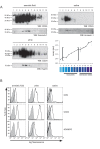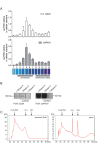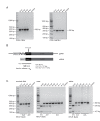Body fluid derived exosomes as a novel template for clinical diagnostics
- PMID: 21651777
- PMCID: PMC3118335
- DOI: 10.1186/1479-5876-9-86
Body fluid derived exosomes as a novel template for clinical diagnostics
Abstract
Background: Exosomes are small membrane vesicles with a size of 40-100 nm that are released by different cell types from a late endosomal cellular compartment. They can be found in various body fluids including plasma, malignant ascites, urine, amniotic fluid and saliva. Exosomes contain proteins, miRNAs and mRNAs (exosome shuttle RNA, esRNA) that could serve as novel platform for diagnosis.
Method: We isolated exosomes from amniotic fluid, saliva and urine by differential centrifugation on sucrose gradients. Marker proteins were identified by Western blot and FACS analysis after adsorption of exosomes to latex beads. We extracted esRNA from exosomes, carried out RT-PCR, and analyzed amplified products by restriction length polymorphism.
Results: Exosomes were positive for the marker proteins CD24, CD9, Annexin-1 and Hsp70 and displayed the correct buoyant density and orientation of antigens. In sucrose gradients the exosomal fractions contained esRNA that could be isolated with sufficient quantity for further analysis. EsRNAs were protected in exosomes from enzymatic degradation. Amniotic fluid esRNA served as template for the typing of the CD24 single nucleotide polymorphism (rs52812045). It also allowed sex determination of the fetus based on the detection of the male specific ZFY gene product.
Conclusions: Our data demonstrate that exosomes from body fluids carry esRNAs which can be analyzed and offers access to the transcriptome of the host organism. The exosomal lipid bilayer protects the genetic information from degradation. As the isolation of exosomes is a minimally invasive procedure, this technique opens new possibilities for diagnostics.
Figures




References
-
- Thery C, Zitvogel L, Amigorena S. Exosomes: composition, biogenesis and function. Nat Rev Immunol. 2002;2:569–579. - PubMed
-
- Andre F, Schartz NE, Movassagh M, Flament C, Pautier P, Morice P, Pomel C, Lhomme C, Escudier B, Le Chevalier T, Tursz T, Amigorena S, Raposo G, Angevin E, Zitvogel L. Malignant effusions and immunogenic tumour-derived exosomes. Lancet. 2002;360:295–305. doi: 10.1016/S0140-6736(02)09552-1. - DOI - PubMed
Publication types
MeSH terms
Substances
LinkOut - more resources
Full Text Sources
Other Literature Sources
Research Materials

